
While I don’t see much benefit in large sets of drawing pencils of various hardness, one shouldn’t overlook the fact that a standard, no.2 pencil is not necessarily the best choice for every task. I find 6H and above are often preferable. I understand they even go up to 10H but these are difficult to find. I issue each of my students a pencil with a hard lead to use throughout the year. They have plenty of advantages to make the purchase worthwhile.
Hard lead pencils don’t break or need sharpening as much. It is not uncommon for a number of students to never need to sharpen their pencil for the entire year! That is not an exaggeration. The higher clay contest make the leads much more durable and resistant to wearing down. The pencil holds a point much longer.
Hard lead pencils draw much lighter. Getting students to draw lightly at the junior high level (and, likely, other levels as well) continues to be a challenge. Some catch on right away while others never quite get it. The problem is, drawing dark is rarely the preferable way to draw. Most of the pencil work we do falls into the preliminary category. In other words, the completed art will be in some other media and pencil showing through will simple take away from the appearance. Lines drawn in a hard lead are less likely to show through marker, colored pencil or paint.
Hard lead pencils are cleaner. Excess graphite tends to smudge and smear leaving hands and artwork filthy. It contaminates paint and marker by affecting the color as one passed over the lines. It also damages markers by getting embedded in the tip. Hard lead pencils simply do not leave as much excess pencil lead on the paper.
Despite these advantages, there are certainly uses which are not as suitable for the harder lead. General shading, for example, is much easier with a more mid-range lead like #2 pencils contain. In my middle school classes, we simply don’t do as many projects that are completed entirely in graphite. Also, hard lead pencils are not as easy to erase as the lead gets more deeply embedded in the surface…particularly if one presses hard. So again, one finds themself reminding their students to use a light pressure. Using graphite to transfer an image, would also require softer lead. Hard lead pencils are most useful for: (1) Under-drawings – drawings which are to be covered with another media. (2) Mechanical drawing – when a precision point and clean lines are needed. (3) Preliminary drawings – using wandering, sketchy lines to later be refined. (4) Under-drawings that are to be inked and scanned or copied – the pencil lines are more easily removed, leaving the ink image. (5) Anytime little or no pencil evidence is detectable on the final image. (6) Compass use – Install them in compasses and one doesn’t have to hassle with removing them to sharpen as often.
Lead hardness, unfortunately, is not completely consistent across the pencil brands.
The above photo show several brands I have had experience with. From left to right: (1) Blick Studio – My students use these currently and 6H is the hardest they manufacture. Available as low as .42 each, they work very well but I wouldn’t mind if harder ones could be purchased. (2) Kimberly 9H – Too soft. It’s difficult to tell it’s even a hard lead. Disappointing because I thought I had found reasonably priced 9H pencils. I can’t recommend them. (3) Prismacolor Turquoise – Good pencils available for around .99 each…Maybe lower if you shop around. It seems a tiny bit softer than the same number in the Blick Studio model. Next time, I will try a harder lead. (4) and (5) Dixon Ticonderoga #4 – I purchased the hard version first not realizing there was a ex-hard available. Comparable to other 6H+ pencils. Very clean and smooth. Great if you prefer an attached eraser. Between $2-4 for a dozen pencils. (6) Derwent Graphic 9H – These are the hardest I have purchased. About $1 each and higher. I have not yet distributed this brand to the students but I’d like to. Feels kind of like drawing with a needle. Very hard; very light marking.
Any of these are great with the exception of the Kimberly 9H. Ticonderoga may the have the potential to be the best deal when purchasing large numbers.

